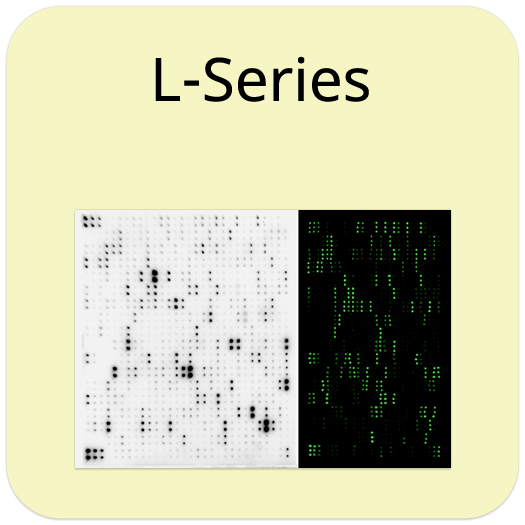Product Features
- High density arrays
- Unbiased detection through direct biotin labeling of samples
- Low sample consumption
- High detection sensitivity
- Same day result
- Affordable and simple to use
Target Names
AADAC, AARS1, AARSD1, ABCB5, ABI3, Acetylcholinesterase, ADAM20, ADGRF3, ADRA1B, ADRA2A, ADRA2B, ADRB2, ADRB3, Aftiphilin, AGGF1, AGTR2, AHCY, AIMP1, AKAP10, AKAP7, ALDH3A1, ALDH7A1, ALKBH1, ALPI, ALS2CR12, AMACR, AMH, AMMECR1, ANKH, ANKMY1, Annexin A3, Annexin A9, APBB1IP, Aprataxin, ARIH2, ARL4A, AS3MT, ASS1, ATF2, ATG4B, ATP5D, ATP6V0A4, ATP6V0C, ATP6V1B2, ATP6V1C1, ATP6V1C2, ATP6V1D, ATP6V1E1, ATP8B4, ATRIP, ATXN7L1, AUP1, BAG4, Barttin, BBOX1, BBS2, BCAP29, BCAP31, BCKDK, Beta-defensin 118, BHLHE41, BOK, BPI, BRF1, BRIP1, BST2, BTBD9, BUB1, BUB3, C1D, C20orf96, CA10, CABP5, CACNB3, CACNG1, CACNG4, Cadherin-8, Calcitonin receptor, CALCRL, Calpain-3, CAMLG, CARD11, CARM1, CASQ1, CASZ1, CCDC134, CCDC8, CCDC9, CCDC91, CCNA1, CD19, CD200R1L, CD37, CD3D, CD72, CDK11B, CDK13, CDK3, CDKN2D, CDON, CDX1, CDYL, CEBPZ, CEND1, CFAP410, CHEK1, CHEK2, CHRM2, CHRNB3, CIB2, CKAP4, Claudin-8, CLN6, CLOCK, CLPX, CMPK1, CNKSR1, CNR1, CNR2, COG3, COL4A3BP, Complexin-2, Copine-1, COPZ2, COQ7, COQ8A, Coronin-2A, COX5B, CRHR1, CRIP2, Cryptochrome-1, CSRP3, CTHRC1, CTNNBIP1, Cyclin-O, Cytochrome b561, Cytochrome P450 7A1, Cytoglobin, Dachshund homolog 1, DARS1, DCDC2, DCTPP1, DEPTOR, DFFB, DHRSX, DIAPH2, DLGAP2, DLX6, DMBT1, DNAJC12, DRP2, DTX1, DZIP3, E2F4, E2F6, EBAG9, EEFSEC, EGR4, EHMT1, EHMT2, EIF4E, EIF5, ELL2, EMC8, Endothelin-3, ENDOU, EPDR1, Erbin, ERN2, ETFDH, ETHE1, ETV3, EXOC6, FANCA, FBXL7, FBXO11, FBXO27, FBXO28, FBXO34, FBXO7, FBXW7, FCER1G, FFAR2, FKBP6, FKBP7, GAS2, GAS7, GCNT1, GFPT1, GGPS1, Golgin-45, GPATCH2, GPR150, GPR19, GPR63, GRAP, GRB14, GRK7, GSTT2B, H2AFY2, Harmonin, HAS1, HDAC4, HEMK1, HES6, HLA-DQA1, HOXB9, HPCA, HSF1, IFNA4, IFT122, IFT81, IGHMBP2, IGLL1, ING5, IRAK4, IRX4, IRX6, IVD, KANK1, KCNA6, KCNC3, KCNG1, KCNH7, KCNIP3, KCNS3, KIAA0355, KIF25, KIFAP3, KIFC1, KIR2DL1, KLHL17, KLHL32, KLK4, L3MBTL2, LHX6, LILRB3, LNX2, LRFN5, LRRC29, LSM1, LYPD6, Lysine--tRNA ligase, MAP2K2, MAP2K5, MAPK14, MBD3L1, MED28, Melanophilin, MEOX2, MERIT40, MID1IP1, MKI67, MKKS, MMAA, MOAP1, MOB1B, MPP2, mRNA, MRPL45, MRPS25, MSH5, MSRB2, MTFR1, MTRR, MYBPC1, MYL2, MYO7A, MYT1, MZB1, N4BP2, NCF2, NCKIPSD, NEMP1, Nephrocystin-1, NFIB, NLGN3, NLK, NLRP5, NMT2, NRAS, NRG4, NSL1, NUBPL, NUDT2, OFD1, Oligophrenin-1, OPTN, OSBPL3, Otoancorin, OTUB2, PAK4, PAK6, Pannexin-1, Paralemmin-1, PAX8, PAXBP1, PCDHB3, PCMTD2, PCP4, PDCD5, PDE2A, PFDN2, PFDN4, PGCD6 (ALG-2), PHF2, PHOSPHO1, Phospholipase DDHD1, PHYH, PIAS4, PIN1, PITPNA, PIWIL2, PKN2, PLCB4, PLEKHA2, PLSCR4, PMVK, PNLIP, POLG, POLG2, PPCDC, PPIG, PPIL1, PPIL2, PPM1B, PPM1G, PPM1L, PPP1R10, PPP1R8, PPP1R9B, PRDM5, PRKAB1, PRKAR1B, PRKCB, PRKCG, PRKD3, PROKR2, Protein argonaute-4, Protein FAM161B, Protein FAM43B, Protein FAM83C, Protein FAM9B, Protein Wnt-7a, Protein Wnt-9b, Protocadherin-17, Protocadherin-18, PRTFDC1, PSG1, PSG6, PSGL-1 (CD162), PSPH, PTGFRN, PTP4A2, PTP-MEG2, PTPRU, PTS, RAB11A, RAB27A, RAB5IF, RABGEF1, RAD18, RAP1A, RAP2A, RASA1, RBPMS, Relaxin receptor 1, Reticulon-1, RFXANK, RGL4, RGS5, RGS6, RHCE, RHOA, RMND5B, RNF11, RNF112, RNF2, RNF217, RNF26, ROBO1, ROM1, RPGR, RRAS2, RRM1, RRM2B, S100A3, SAE1, SCML2, SEC13, SEC14L1, SECISBP2L, SEMA3F, SENP8, SERINC2, SERPINB9, SERPINI2, SETD7, SIAE, SIAH2, Sideroflexin-2, SIN3B, SIX6, SLBP, SLC12A1, SLC13A1, SLC25A2, SLC35A2, SLC35A3, SLC6A18, Slit2, SMPDL3A, SNAPC2, SNIP1, Sorting nexin-8, SPINK4, SPPL2A, SRCIN1, SRFBP1, SRI, SRPK1, ST3GAL2, STAC, STK17B, STK31, STX3, STXBP1, SUB1, SULT1A1, SUN1, SUN2, Synapsin-3, Synaptogyrin-3, Synaptotagmin-11, Syntaphilin, Syntaxin-1B, Syntaxin-5, SYS1, TAOK3, TARBP2, TBC1D14, TCF4, Teneurin-2, Teneurin-4, TESK2, TET3, TEX13B, TEX264, TGIF2LX, THAP6, TIMM10B, TIMM17A, TIMM17B, TMC2, TMCC2, TMED10, TMEM199, TMEM25, TNFAIP8, TNIP1, TNRC6A, TRAIP, TRAK1, TRIAP1, TRIM23, TRIM31, TRIM7, TSC1 (Hamartin), TSC22D1, TSEN34, TSPAN7, TTC14, TUB, TUBA1A, UBE2D1, UBE2D4, UBR5, UBXN2A, USP13, USP36, USP38, Vang-like protein 2, WASL, Wnt-2b, XK, ZBTB20, ZCCHC4, ZFHX2, ZIM2, ZNF219, ZNF232, ZNF280A, ZNF280B, ZNF282, ZNF384, ZNF410, ZNF483, ZNF512B, ZP2, ZW10 interactor
Application Notes
Suggested Application
Multiplexed Protein Detection; Detection of Relative Protein Expression; Detecting Patterns of Cytokine Expression; Biomarker Screening; Identifying Key Factors; Confirming a Biological Process; Cross-species testing
Kit Components
- RayBio® L-Series Antibody Array Glass Slide(s)
- Spin Columns
- Labeling Reagent
- Stop Solution
- Blocking Buffer
- Wash Buffer 1
- Wash Buffer 2
- Streptavidin-Conjugated Fluor
- Adhesive Plastic Strips
- Labeling Buffer
- Lysis Buffer
- 30 ml Centrifuge Tube
Other Materials Required
- Distilled or de-ionized water
- Small plastic or glass containers
- Orbital shaker or oscillating rocker
- 1 ml tube
- Pipettors, pipette tips and other common lab consumables
- Aluminum foil
- Gene microarray scanner or similar laser fluorescence scanner
View Compatible Laser Scanners
Don't have a compatible scanner? RayBiotech now offers FREE scanning service for all RayBio glass slide antibody arrays! Learn More
Protocol Outline
- Purify Samples with Spin Column
- Biotinylate Samples
- Purify biotinylated samples using spin column
- Dry the glass slide
- Block array surface
- Incubate with Samples
- Incubate with Streptavidin-Conjugated Fluor
- Disassemble the glass slide
- Scan with a gene microarray laser scanner
- Perform densitometry and analysis
Storage/Stability
For best results, store the entire kit frozen at -20°C upon arrival. Stored frozen, the kit will be stable for at least 6 months which is the duration of the product warranty period. Once thawed, store array slide(s) at -20°C and all other reagents undiluted at 4°C for no more than 3 months.


